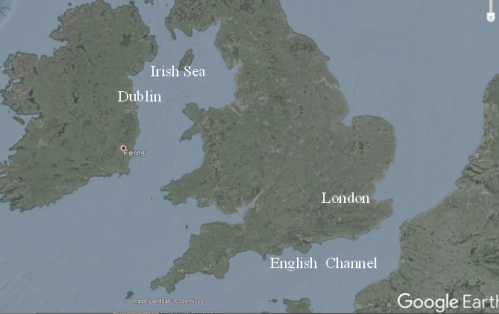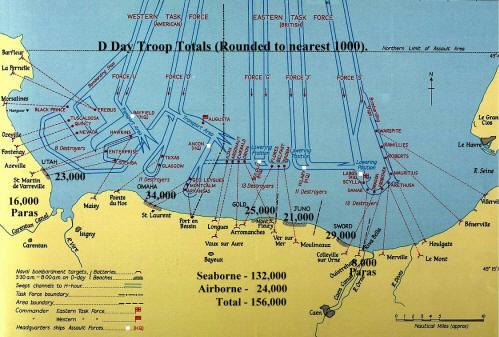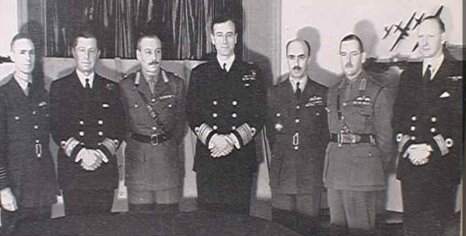|
Rickard Charles Donovan RN, CBE, (1898-1952)
Combined Operations Command HQ Staff (Royal
Navy)
 As
part of his duties at the Combined Operations Command HQ (COHQ) in London, Irishman Rickard Donovan was involved in planning
for the D-Day
landings of June 6th,
1944, which history attests was a defining,
historical
moment for the world. This is a short biography
and appreciation of his life and times. As
part of his duties at the Combined Operations Command HQ (COHQ) in London, Irishman Rickard Donovan was involved in planning
for the D-Day
landings of June 6th,
1944, which history attests was a defining,
historical
moment for the world. This is a short biography
and appreciation of his life and times.
Background
In WW2 he served in the COHQ during the
tenure of Roger Keyes and
later Mountbatten. He was involved in
important aspects of naval planning including the D-Day
landings when hundreds of thousands of men from the 3 services of
the Allied
nations were deployed together with their armaments, equipment, transport,
stores, medical services, communications, intelligence services, radar, fuel and
food. All were
delivered to hundreds of locations at a specific time along a 50 mile front. Logistically, even in the early weeks following D Day,
it was the equivalent of meeting the daily needs of the
population of a city the size of Edinburgh,
while on the move and fighting a
determined enemy!
[Photo;
Rickard Donovan, right, receiving the Legion of
Merit in 1946].
On D-Day itself,
Allied Forces landed on the defended beaches of Normandy, which formed part of
Hitler's 'Atlantic Wall'. Paratroops
dropped behind enemy lines a few miles
inland of the beaches
at their most easterly and westerly extremities. The amphibious invasion force was the largest in human history,
which utilised around 40 different designs of flat bottomed landing craft to reach the beaches in
shallow coastal waters. In support
of the troops
were landing craft adapted for firing rockets, mortars, guns etc.
The airborne forces
were transported by
planes
and gliders with fighter
air cover.
With the Russian forces advancing on the eastern front and the
opening up of this second front in the west, the seeds of Hitler's suicide and
the unconditional surrender of the German forces less than a year later, were
sown. While the contributions of the Army, Navy and Air Force
on D-Day are well-documented, the role of the co-ordinating service, Combined
Operations, is less well understood and acknowledged, despite its pivotal role in
the success of the D-Day landings.
However, there was a significant group of men who had no doubt about the
invaluable work undertaken by Combined Operations. After visiting the beaches of
Normandy on D-Day + 6, Churchill and his military advisers sent a signal to
Mountbatten;
‘Today we visited the British and American Armies on the soil of France. We
sailed through vast fleets of ships with landing-craft of many types pouring
more men, vehicles and stores ashore. We saw clearly the manoeuvre in progress
of rapid development. We have shared our secrets in common and helped each
other all we could. We wish to tell you at this moment in your arduous
campaign that we realise how much of this remarkable technique and therefore
the success of the venture has its origin in developments effected by you and
your staff of Combined Operations.
(Signed) Arnold, Brooke, Churchill,
King, Marshall, Smut.’
 The
Formative Years The
Formative Years
Donovan was born in 1898, the
son of an ascendancy family from Ballymore near Ferns in County Wexford. At
the age of 13 he attended the Royal Naval Colleges in Osborne and Dartmouth,
England to qualify for a career in the Royal Navy. His parents' objective was
to establish their son in a solid career to ensure the survival of their
home and to secure their future in Ireland after the break up of their estate under the
Land Reform Acts.
He was promoted to Midshipman at the outbreak of WWI in 1914
and assigned to the battleship HMS Ocean, on
which he served until it was sunk by a mine in the Dardanelles on 18/03/15.
According to family legend he was the last man off the ship since the Captain sent
him back to the abandoned vessel to recover the ship’s log.
In 1916,
the rapid expansion
of the British submarine
fleet
created an urgent need
for captains
to command them. Being a relatively new service
there was no available pool of officers with the
required knowledge, skills and experience.
Consequently, young naval officers of proven ability and suitable personal
qualities
were recruited.
Perhaps this was the first time since the
Napoleonic wars that young officers achieved such rapid promotion.
S![Rickard Donovan, extreme right, with fellow submariners.]](COM_PHOTOS/Rickard%20Donovan%20with%20colleagues_small.jpg) ervice in the Submarine Corps
had huge financial rewards and the rare opportunity to captain a vessel at a
remarkably young age. His first
command was submarine L7 and he quickly distinguished himself as a competent
submarine commander. He took part in several naval
battles and was promoted to Sub-Lieutenant. His superior officer, in May
1916, reported that he ‘carries out duties well and intelligently.' [National
Archive (NA),
[ADM 196/120, p.135]. ervice in the Submarine Corps
had huge financial rewards and the rare opportunity to captain a vessel at a
remarkably young age. His first
command was submarine L7 and he quickly distinguished himself as a competent
submarine commander. He took part in several naval
battles and was promoted to Sub-Lieutenant. His superior officer, in May
1916, reported that he ‘carries out duties well and intelligently.' [National
Archive (NA),
[ADM 196/120, p.135].
[Photo; Rickard Donovan, extreme right, with
fellow submariners].
By
the age of 19 his submarine command comprised naval cadets, often as young as
15. Their mission was to attack Turkish vessels in the Dardanelles. The
submarines leaked constantly, were very cramped and hazardous to work in and
there were constant problems with the engines and air-circulation. Clearly
opportunity came at a price as Donovan was to find out to his cost in
the years ahead. From 1917, he undertook further submarine training,
which became his main activity for the remainder of WWI. During this period, he trained at HMS
Vulcan, HMS
Dolphin (10/17
– 01/18) and then HMS
Ambrose to the end of the war.
Between
the Wars
After the WW1, Donovan was assigned to HMS
Vulcan and many other submarine depot ships, as well as being given command
of submarines such as the K22 and H33. He was promoted to a full Lieutenant in
April 1919 and his service record of Dec 1920 opined ‘promising,
very keen and zealous, cheerful temperament, good example, good leadership,
judgement and firm decision, smart’. [TNA, ADM 196/120, p.135].
This promising career belied a
serious health problem acquired during his life as a submariner. He had
tuberculosis for which there was no effective treatment at the time. By 1927,
having reached the rank of Lieutenant Commander, the disease had progressed and he was invalided out of the Navy and granted a disability
pension.
With
almost 10 years submariner service behind him, he was hired by
William Beardmore & Co., Engineers and Shipbuilders on the River Clyde in Scotland,
where he worked
on the development of cleaner and more efficient diesel engine. Ironically,
his work would improve the air quality and general working conditions of future
submariners; the very conditions which caused his serious illness. Although the engine was a
significant technological development, between the two world wars
it provided no job security after the 1929 stock market crash and the subsequent
economic depression.
He
tried many different jobs to provide for his family
including a door-to-door china salesman in London! However, his main priority was
to find work in Ireland and in the 1930s he enlisted the help of the Admiralty.
In 1937, he joined the London & Thames Haven Oil Company and helped set up Irish National Refineries. They planned to build
a major oil refinery in Dublin Bay but the fledgling firm was taken over by
competing oil majors who feared the competition and they closed it down. His RN
service records mention his ‘considerable experience in business ashore’ and his
oil contacts as being important in his role with the Navy in WW2. [TNA, ADM
340/242].
Combined
Operations

At the outbreak of WWII, Donovan rejoined the
navy and was assigned to Combined Operations in its first incarnation under Sir
Roger Keyes, who was Director between July 1940 and October 1941. Combined
Operations drew on the best practices and expertise available within the Royal
Navy, the Army and the Royal Air Force to create a new unified force. Many of
the Services’ top planners and experts formed the nucleus of the COHQ. Although much was achieved during this period,
including the formation of the Commandos, the
relationship between the Director of Combined Operations (Keyes) and the Chiefs of Staff of the 3
Services, deteriorated to the detriment of the overall objective of working
together to defeat the enemy. With a heavy heart, Churchill appointed Lord Louis
Mountbatten to a newly defined post. His diplomatic skills heralded the start of
a more harmonious collaboration between the COC and the Chiefs of Staff.
Mountbatten
soon established himself as the Chief of Combined Operations, while gaining the
confidence and respect of the Chief's of Staff. In 1942, with Churchill's
support, Mountbatten attended meetings of the Chiefs of Staff on an equal
footing, effectively making Combined Operations the ‘fourth armed service’
alongside the Navy, Army and Air Force, overturning long established armed
services protocols. To this day, almost all histories of WWII erroneously refer
to Combined Operations as a temporary creation, which held an advisory or
subordinate place amongst the Joint Chiefs of Staff. Although the vital and
immense role of Combined Operations concluded at the end of WWII, it was not
subordinate to the three traditional armed forces, a fact supported by official
records.
Mountbatten introduced major
changes to personnel, organisation and communications and Donovan was rapidly
promoted, his service record describing him as
‘an exceptional staff officer in every way’. In 1942/43, he worked in the
Plans Division and, in August of 1943, was promoted to Assistant Director of
Plans with an Acting Rank of Captain . In December 1943, he was promoted to Deputy Director of Combined Operations and in
1944 to
Senior Deputy Director.
Essential
to the
planning of the D-Day landings was the coordination of the disparate
contributions of the 3 services. It was
a hugely complex task involving many hundreds of people from all services; an
astonishing achievement completed without modern communications and computer
technology. There was an absolute need for total secrecy and very few involved
in the planning process, were privy to information beyond what they needed to
know to perform their individual tasks Donovan was an exception who
worked out the detailed plans for Operations Neptune and Overlord and for
directing their implementation.
 Captain Robert Ellis,
Assistant Chief of Combined Operations, wrote ‘It is my opinion that the
successful expansion of our naval amphibious resources owes much more to his
[sic. Rickard Donovan’s] brilliant work than to any other single factor. I have been
particularly struck by his loyalty and patience in difficult and disappointing
circumstances, when these have arisen.’ [TNA, ADM 196/120, ADM 196/146,
quote from ADM 340/242]. Captain Robert Ellis,
Assistant Chief of Combined Operations, wrote ‘It is my opinion that the
successful expansion of our naval amphibious resources owes much more to his
[sic. Rickard Donovan’s] brilliant work than to any other single factor. I have been
particularly struck by his loyalty and patience in difficult and disappointing
circumstances, when these have arisen.’ [TNA, ADM 196/120, ADM 196/146,
quote from ADM 340/242].
[Photo; COHQ 13/4/42: L to R, Group Captain A H Willets, Rear Admiral E H Horan, Major General J
C Haydon, Lord Louis Mountbatten, Air Vice Marshall J M Robb,
Brigadier G E Wildman-Lushington (Royal Marines) and Commodore R M
Ellis].
Donovan
was often very ill during his time with Combined
Operations. The TB he had contracted as a teenager aboard submarines was
untreatable in those days and in January 1944 he was hospitalised. He was placed on enforced sick-leave,
which, initially, allowed him to return to service for a month, subject to
monthly review on condition that he avoided stress
and long hours; an impossibility for anyone involved in D-Day
planning. Despite his illness, his involvement at this critical juncture was
vital.
His son recalled that his father ‘did
not allow his bad-health to interfere with his war-time commitments.’
Following the success of D-Day,
Donovan's role in COHQ changed with his appointment in 1945 to the position of
Chairman of the Eastern Landing Craft Base Committee, where his knowledge,
skills and experience gained over the previous years, would be applied to the
conflict in the far east. With the surrender of the Japanese all planning for
offensive operations were cancelled.
Donovan
was retained by the Admiralty to write a detailed narrative on the development
of Combined Operations. Among the family papers in Wexford is a typescript draft
copy of this history, with final revisions marked up in his own hand. These corrections are particularly interesting, as they
show a refinement in his thoughts as he put the story of Combined
Operations down on paper.
In May 1946, he reverted to the
retired list (medically unfit) of the Royal Navy. In recognition of his
contribution during WWII he was awarded a CBE in 1945 by the British and the
Legion of Merit (Degree of Officer) by the USA, both in recognition of distinguished
service to the Allied cause during the war.
_small.jpg) Postscript Postscript
Rickard Donovan was very clear about his Irish identity, be that
within the British Empire or as an independent state. Among the family papers
are his notes on proposals for treaty negotiations with Irish Prime
Minister, de Valera, during WWII designed
to bring Ireland into the war. In them he shows a remarkable clarity of the
issues involved, a dislike of Churchill’s stubbornness and a respect for de Valera’s position of neutrality.
Although his career kept him in England he maintained strong connections
with Ireland and he always considered his home as Ballymore in County Wexford.
Even at the height of WWII he took every opportunity to visit home. His mother
and sisters remained in Wexford and he worked closely with them to maintain
the family farm as a viable enterprise, but also to assist his sisters’
other
entrepreneurial efforts including the re-establishment of Carley's pottery in
Enniscorthy.
He died in London in 1952 at the age of 54
and was interred on a hillside overlooking the sea at the
family farm in Ballymore. To his
neighbours he was simply known as “the Captain”.
There is a
memorial to the Combined Operations Command at the National Memorial Arboretum
in Staffordshire,
which was dedicated on July 4, 2013.
Visit the 'Memorial Index'
page for information on the design,
construction, funding, dedication ceremony etc.
Further Reading
There are around 300 books listed on
our 'Combined Operations Books' page. They, or any
other books you know about, can be purchased on-line from the
Advanced Book Exchange (ABE). Their search banner link, on our 'Books' page, checks the shelves of
thousands of book shops world-wide. Just type in, or copy and paste the
title of your choice, or use the 'keyword' box for book suggestions.
There's no obligation to buy, no registration and no passwords.
From the website 'Books' page the following are copied here for your
convenience.
Hilary St.George Saunders.
Combined Operations : the official story of the Commandos.
New York : Macmillan, 1943 : xiii, 155 p
Bernard Fergusson.
The Watery Maze : the story of Combined Operations.
London : Collins, 1961
: 445 p
(Recommended).
James D. Ladd.
Combined Operations.
London : Dragon Grafton Books,
1986 : 48 p : ISBN 0-583-31004-4 : [Modern military techniques].
Ministry of Information.
Combined Operations 1940 -1942.
London, HMSO : 144 p
Other books and websites of possible
interest
Stephen E. Ambrose, Day June 6, 1944: The Climactic Battle of World War II,
1994
Douglas Botting, The Second Front - World War II, 1978
John Keegan, Six Armies in Normandy, 1982
https://theddaystory.com/discover/what-is-d-day/
The US Army and D-Day
 Acknowledgements Acknowledgements
This account of Rickard Donovan's life and times is based on research
undertaken
by Fiona Fitzsimons, Director of Research at Eneclann using letters, papers and
photographs from family archives together with service records and documents held
in the UK National Archives at Kew. The assistance of Brian Donovan, grandson of
Rickard Donovan, is gratefully acknowledged in the preparation of this page.
The text and presentation were
approved by him before
publication.
|


![Rickard Donovan, extreme right, with fellow submariners.]](COM_PHOTOS/Rickard%20Donovan%20with%20colleagues_small.jpg)


_small.jpg)

